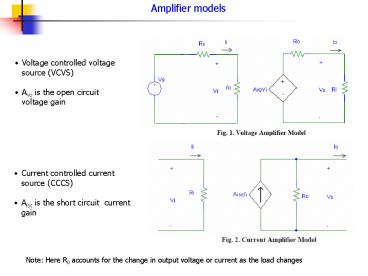Amplifier models - PowerPoint PPT Presentation
1 / 16
Title:
Amplifier models
Description:
Title: Multi-functional Packaged Antennas for Next-Generation Wireless Applications Last modified by: koley Created Date: 1/18/2003 12:04:48 PM Document presentation ... – PowerPoint PPT presentation
Number of Views:42
Avg rating:3.0/5.0
Title: Amplifier models
1
Amplifier models
- Voltage controlled voltage source (VCVS)
- Avo is the open circuit voltage gain
- Current controlled current source (CCCS)
- Aisc is the short circuit current gain
Note Here R0 accounts for the change in output
voltage or current as the load changes
2
Conversion from VCVS to CCCS
Thus a VCVS can be converted to a CCCS by first
finding the current gain Aisc and then putting
the series output resistance R0 in case of VCCS
parallel to the current source.
3
Examples on conversion
For a voltage amplifier, if Ri 1 K?, Av0 100,
and R0 100 ?, then draw the equivalent current
amplifier circuit.
Solution The current gain Aisc is calculated as
Av0Ri/R0 1000 The output resistance remains the
same but now is in parallel. Input resistance is
the same. Thus, the overall circuit looks like
shown at the side.
Reverse conversion from voltage to current
amplifier
Consider a current amplifier of Ri 1 k?, R0
20 ?, and short circuit current gain 200.
Convert into an equivalent voltage amplifier
circuit
Solution The voltage gain Avc is calculated as
AiscR0/Ri 4 The output resistance remains the
same but now is in series. Input resistance is
the same.
4
Transconductance and transresistance amplifier
models
Transconductance amplifier model Input is
voltage, output is current
Short circuit transconductance gain
Transresistance amplifier model Input is
current, output is voltage
5
Example
Determine the transconductance and
transresistance amplifier models for the
amplifier shown in the above figure.
6
Summary of different types of amplifiers
So, given the basic voltage amplifier model, you
should be able to determine all the other models
7
Practical applications of different i/p and o/p
impedances 1
Variable input impedance of the human body. This
happens mainly due to the change in conditions of
the skin
High input impedance of Electro-cardiograph is
necessary
The voltage across the ECG machine is Vs x
Ri/(Ri Rs), which is to be measured. Therefore
, the higher the input impedance Ri compared to
Rs, the lesser is the variation in input voltage
8
Practical applications of different i/p and o/p
impedances 2
Low input resistance of the ammeter is necessary
(so as to not load the circuit, and reduce the
current that it is trying to measure).
In summary
9
Practical example of low o/p impedance of the
source
Audio amplifiers in various rooms of an office
building
If the amplifier feeds several loudspeakers then
for different switching conditions, the load will
be different for the amplifier, and the sound
intensity will be different, which is
undesirable. However, if the amplifier output
impedance R0 is much less than the (lowest) load
resistance, the load voltage is nearly
independent of the number of amplifiers turned on
or off.
10
1.9 Ideal Amplifiers
11
Basic amplifier concepts
1.10 Amplifier Frequency Response
- Any periodic signal can be broken down into
sinusoidal components by Fourier analysis
12
Basic amplifier concepts
- An amplifier good for a particular frequency
range should linearly amplify the signal
(containing multiple frequencies) in that range.
13
Complex Gain
Basic amplifier concepts
Q What is a Phasor?
A Phasor is an ac voltage or current that
maintains the same phase with respect to a
standard reference. Thus, in a circuit the
quantities can have a constant phase relationship
independent of time.
14
Basic amplifier concepts
15
Basic amplifier concepts
Avmid
Avmid
- AC coupled amplifiers will always have zero gain
at dc voltage. Examples include audio amplifiers
and ECG amplifiers, where application of dc
signal is undesirable. - A DC-coupled amplifier will have a constant gain
down to very low frequencies and also dc. Example
include amplifiers for video signals.
16
Basic amplifier concepts
The gain of an amplifier reduces at higher
frequencies. This is due to the parasitic
capacitance and inductances as shown in Fig.
1.38. Stray capacitances occur between the
conductor and the ground, while stray inductances
happen due to the conductor surrounded by a
magnetic field (created by current flow).































